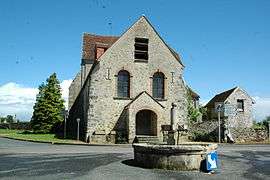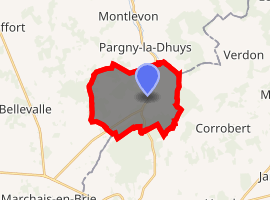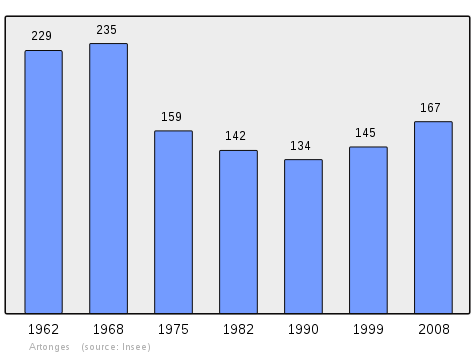Artonges
Artonges is a former commune in the department of Aisne in northern France. On 1 January 2016, it was merged into the new commune Dhuys-et-Morin-en-Brie.[2]
Artonges | |
|---|---|
Part of Dhuys-et-Morin-en-Brie | |
 | |
Location of Artonges 
| |
 Artonges  Artonges | |
| Coordinates: 48°55′48″N 3°33′13″E | |
| Country | France |
| Region | Hauts-de-France |
| Department | Aisne |
| Arrondissement | Château-Thierry |
| Canton | Essômes-sur-Marne |
| Commune | Dhuys-et-Morin-en-Brie |
| Area 1 | 13.12 km2 (5.07 sq mi) |
| Population (2017)[1] | 164 |
| • Density | 13/km2 (32/sq mi) |
| Time zone | UTC+01:00 (CET) |
| • Summer (DST) | UTC+02:00 (CEST) |
| Postal code | 02330 |
| Elevation | 140–211 m (459–692 ft) (avg. 165 m or 541 ft) |
| 1 French Land Register data, which excludes lakes, ponds, glaciers > 1 km2 (0.386 sq mi or 247 acres) and river estuaries. | |
The inhabitants of the commune are known as Artongeois or Artongeoises[3]
Geography
Artonge is a commune in the south of the department of Aisne in the old Brie Champagne region, located on a high plateau not far from the sources of the Dhuys and the edge of the forest of "Rouges Fossés" (Red Ditches).
It is located some 20 km south-east of Château-Thierry and 35 km south-west of Épernay. It can be accessed by the D20 road from Pargny-la-Dhuys in the north coming south through the village and continuing south-west to Marchais-en-Brie. The D201 branches south off the D20 changing to the D40 at the border of the commune and continuing south to Montmirail. There is also the D866 coming from Nesles-la-Montagne in the north-west terminating in the village. There is also a railway line coming from the north with Artongeole Station just north of the village. The railway continues south-west through Montmirail. The commune is mixed farmland and forest.[4]
The Ru des Rieux flows through the village from its source to the west and flows south-west into the Ravine de la Dhuys.[4]
Neighbouring communes and villages[4]
History
The name Hertungiae was mentioned in 1137.
Administration
List of Mayors of Artonges[5]
| From | To | Name | Party | Position |
|---|---|---|---|---|
| 2001 | 2008 | François Girard | ||
| 2008 | 2020 | Gislaine Dadou |
(Not all data is known)
Demography
In 2010, the commune had 184 inhabitants. The evolution of the number of inhabitants is known through the population censuses conducted in the town since 1793. From the 21st century, a census of municipalities with fewer than 10,000 inhabitants is held every five years, unlike larger towns that have a sample survey every year.[Note 1]
| 1793 | 1800 | 1806 | 1821 | 1831 | 1836 | 1841 | 1846 | 1851 |
|---|---|---|---|---|---|---|---|---|
| 245 | 294 | 298 | 267 | 256 | 255 | 268 | 281 | 314 |
| 1856 | 1861 | 1866 | 1872 | 1876 | 1881 | 1886 | 1891 | 1896 |
|---|---|---|---|---|---|---|---|---|
| 311 | 300 | 305 | 311 | 286 | 277 | 295 | 272 | 296 |
| 1901 | 1906 | 1911 | 1921 | 1926 | 1931 | 1936 | 1946 | 1954 |
|---|---|---|---|---|---|---|---|---|
| 277 | 270 | 270 | 249 | 229 | 234 | 237 | 199 | 197 |
| 1962 | 1968 | 1975 | 1982 | 1990 | 1999 | 2006 | 2010 | - |
|---|---|---|---|---|---|---|---|---|
| 229 | 235 | 159 | 142 | 134 | 145 | 159 | 184 | - |

Sites and Monuments
- The Choir and the Transept of the Church of Saint Peter (15th century)


- The Fountain is powered by a reliable source of water which was once thought to cure sore throats and fevers.
- The Lavoir (Public laundry) is decorated on the theme of a fable by Jean de La Fontaine: "The fox, the flies, and the hedgehog".
- The Chateau is a former lordship which was vassal to Montmirail and is privately owned.
See also
External links
- Artonges on the old National Geographic Institute website (in French)
- Artonges on the Canton of Condé-en-Brie official website (in French)
- Bell Towers website (in French)
- Artonges on Lion1906
- Artonges on Géoportail, National Geographic Institute (IGN) website (in French)
- Artonges on the 1750 Cassini Map
Notes and references
Notes
- At the beginning of the 21st century, the methods of identification have been modified by law No. 2002-276 of 27 February 2002 , the so-called "law of local democracy" and in particular Title V "census operations" which allow, after a transitional period running from 2004 to 2008, the annual publication of the legal population of the different French administrative districts. For municipalities with a population greater than 10,000 inhabitants, a sample survey is conducted annually, the entire territory of these municipalities is taken into account at the end of the period of five years. The first "legal population" after 1999 under this new law came into force on 1 January 2009 and was based on the census of 2006.
References
- Téléchargement du fichier d'ensemble des populations légales en 2017, INSEE
- Arrêté préfectoral 10 September 2015 (in French)
- Inhabitants of Aisne (in French)
- Google Maps
- List of Mayors of France (in French)
- Ministry of Culture, Mérimée PA00115508 Church of Saint Peter (in French)
- Ministry of Culture, Palissy PM02000042 Stained glass window: Christ on the Cross (in French)
| Wikimedia Commons has media related to Artonges. |